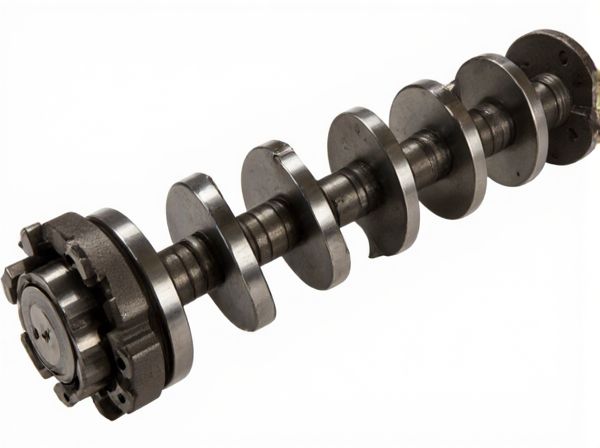
Photo illustration: Full-round vs Cut-down Counterweight Crankshaft
Full-round counterweight crankshafts provide balanced mass distribution, reducing engine vibrations and improving overall performance. Cut-down counterweight crankshafts are lighter, enhancing engine responsiveness and fuel efficiency but may compromise some vibration damping. Choosing the right option depends on your performance goals and the specific requirements of your engine design.
Table of Comparison
| Feature | Full-Round Counterweight Crankshaft | Cut-Down Counterweight Crankshaft |
|---|---|---|
| Weight | Heavier due to full-radius counterweights | Lighter by removal of excess material |
| Balance | Superior dynamic balance for reduced vibration | Reduced balance; may cause increased vibration |
| Performance | Optimized for smooth engine operation | Improved acceleration due to lower rotational inertia |
| Durability | Higher structural integrity | Potential stress concentration points |
| Cost | Generally more expensive to manufacture | Lower cost, simpler machining |
| Use Case | Suitable for high-performance and heavy-duty engines | Preferred in lightweight or racing applications |
Introduction to Crankshaft Counterweights
Crankshaft counterweights play a critical role in balancing engine vibrations and reducing stress on the crankshaft during operation. Full-round counterweights provide a larger mass for improved balance and smoother engine performance, while cut-down counterweights are lighter and tailored for applications requiring reduced rotating mass and increased engine responsiveness. The choice between full-round and cut-down counterweights directly influences engine durability, balance efficiency, and overall performance characteristics.
What is a Full-round Counterweight Crankshaft?
A Full-round Counterweight Crankshaft features counterweights that are completely rounded to provide optimal balance and reduce engine vibrations. This design enhances the crankshaft's structural integrity, leading to improved durability and smoother engine performance. Full-round counterweights are commonly used in high-performance and heavy-duty engines where minimizing imbalance is critical.
What is a Cut-down Counterweight Crankshaft?
A cut-down counterweight crankshaft features reduced mass in its counterweights to decrease inertia and improve engine response, making it ideal for high-revving applications. This design optimizes rotational balance by selectively removing material, thereby enhancing acceleration and fuel efficiency without compromising durability. Compared to full-round counterweights, cut-down versions offer better throttle response and reduced stress on engine components.
Engineering Differences: Full-round vs Cut-down
Full-round counterweight crankshafts feature continuous, unmodified counterweights that provide balanced rotational inertia, enhancing engine smoothness and reducing vibrations. Cut-down counterweight designs remove portions of the mass to optimize weight distribution and reduce overall crankshaft inertia, which improves engine responsiveness and efficiency. Engineering differences center on material distribution and dynamic balance, with full-round types prioritizing stability while cut-down types prioritize performance gains through weight savings.
Performance Impact: Vibration and Harmonics
Full-round counterweight crankshafts provide superior balance by evenly distributing mass, significantly reducing engine vibrations and minimizing harmonic distortions during operation. Cut-down counterweights, while lighter and potentially improving engine responsiveness, often introduce increased vibrational forces and harmonics that can compromise smooth performance and longevity. Optimizing crankshaft design for vibration control is critical in high-performance engines to maintain consistency, durability, and overall mechanical efficiency.
Weight Considerations for Crankshaft Selection
Full-round counterweight crankshafts offer superior balance and durability but typically weigh more, increasing rotational mass and potentially reducing engine responsiveness. Cut-down counterweights reduce overall crankshaft weight, enhancing acceleration and throttle response, though they may compromise harmonic damping and longevity under high-stress conditions. Weight considerations for crankshaft selection depend on balancing the need for strength and engine smoothness against performance goals such as minimizing rotational inertia.
Durability and Reliability of Counterweight Designs
Full-round counterweight crankshafts provide superior durability by distributing stress evenly across the entire counterweight, reducing fatigue and potential cracking under high loads. Cut-down counterweights, while lighter and offering improved engine responsiveness, may concentrate stress at the edges, potentially compromising long-term reliability in high-stress applications. Optimizing counterweight design for durability involves balancing weight reduction with material strength and stress distribution to enhance crankshaft longevity and consistent engine performance.
Application Suitability: Racing vs Daily Driving
Full-round counterweight crankshafts offer superior balance and reduced vibration, making them ideal for high-performance racing engines that demand maximum RPM and durability. Cut-down counterweight crankshafts are lighter and provide quicker throttle response, suited for daily driving where efficiency and smooth operation at lower RPM ranges are prioritized. Racing applications benefit from the enhanced stability of full-round designs, while daily driving favors the practicality and fuel efficiency of cut-down configurations.
Cost and Manufacturing Complexity
Full-round counterweight crankshafts typically incur higher manufacturing complexity due to the precision machining required to shape entire circular counterweights, increasing production time and tooling costs. Cut-down counterweights reduce material usage and simplify machining processes, resulting in lower costs and faster production cycles. However, the cost savings must be balanced against potential compromises in balance and engine vibration control inherent to cut-down designs.
Choosing the Right Counterweight Crankshaft
Choosing the right counterweight crankshaft requires analyzing engine balance, weight distribution, and application-specific performance demands. Full-round counterweights offer superior vibration reduction and smoother operation ideal for high-performance and high-RPM engines, while cut-down counterweights provide lighter weight and improved acceleration response suited for racing or lightweight builds. Evaluating engine dynamics, operational RPM range, and durability goals ensures optimal crankshaft performance and longevity.
 caratoz.com
caratoz.com